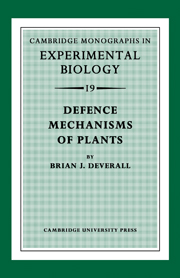Book contents
- Frontmatter
- Contents
- Preface
- 1 INTRODUCTION TO THE HOST–PARASITE INTERACTION
- 2 DISCRIMINATORY EVENTS BEFORE AND DURING PENETRATION INTO PLANTS
- 3 CYTOLOGICAL CHANGES IN HOST AND PARASITE AFTER INFECTION
- 4 CROSS-PROTECTION AND INDUCED RESISTANCE
- 5 PHYTOALEXINS AND THEIR INDUCED FORMATION AND BIOSYNTHESIS
- 6 ROLE OF PHYTOALEXINS IN DEFENCE MECHANISMS
- 7 MEDIATION OF HOST–PARASITE SPECIFICITY
- References
- Index
2 - DISCRIMINATORY EVENTS BEFORE AND DURING PENETRATION INTO PLANTS
Published online by Cambridge University Press: 10 May 2010
- Frontmatter
- Contents
- Preface
- 1 INTRODUCTION TO THE HOST–PARASITE INTERACTION
- 2 DISCRIMINATORY EVENTS BEFORE AND DURING PENETRATION INTO PLANTS
- 3 CYTOLOGICAL CHANGES IN HOST AND PARASITE AFTER INFECTION
- 4 CROSS-PROTECTION AND INDUCED RESISTANCE
- 5 PHYTOALEXINS AND THEIR INDUCED FORMATION AND BIOSYNTHESIS
- 6 ROLE OF PHYTOALEXINS IN DEFENCE MECHANISMS
- 7 MEDIATION OF HOST–PARASITE SPECIFICITY
- References
- Index
Summary
Many micro-organisms are dispersed in air currents or in splash droplets caused by rain, and thereby arrive on leaves and stems. Other fungi and bacteria move in soil water before encountering roots or persist as resting stages until roots grow into their vicinity. Plants can then influence micro-organisms around their surfaces by physical and chemical means, thus starting an interaction which must be followed by entry of the parasite into the plant by a specialized route, if parasitism is to have a chance of success. This chapter is concerned with the few attempts that have been made to assess quantitatively the contributions to the success or failure of parasitism of these primary interactions between potential parasites and hosts.
EFFECT OF ROOTS ON PARASITES IN THE SOIL
The principal effect of roots on organisms in the soil is a general stimulation of germination and growth, and this is particularly important for parasites most of which remain dormant until contacted by their living substrates. Fungal parasites lie dormant in soil as a number of different types of resting body such as sclerotia, oospores, chlamydospores, basidiospores and hyphal fragments. Their dormancy is considered to be of two types, constitutive or exogenous (Sussman, 1966). Constitutive dormancy is thought to be maintained by internal factors in the fungus, and is particularly important in basidiospores. Experimentally, constitutive dormancy can be broken, in at least a small proportion of spores, by temperature shocks, treatment with certain chemicals, and proximity to other micro-organisms and some plant roots in culture.
- Type
- Chapter
- Information
- Defence Mechanisms of Plants , pp. 7 - 17Publisher: Cambridge University PressPrint publication year: 1977



